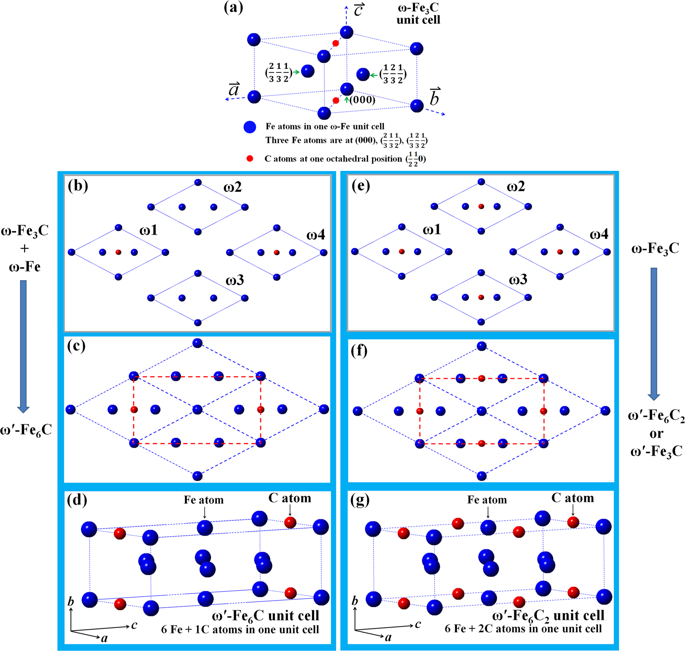Scientific Reports ( IF 3.8 ) Pub Date : 2020-04-08 , DOI: 10.1038/s41598-020-63012-9 D. H. Ping , H. P. Xiang , H. Chen , L. L. Guo , K. Gao , X. Lu

|
Carbon steel is strong primarily because of carbides with the most well-known one being θ-Fe3C type cementite. However, the formation mechanism of cementite remains unclear. In this study, a new metastable carbide formation mechanism was proposed as ω-Fe3C → ω′-Fe3C → θ′-Fe3C based on the transmission electron microscopy (TEM) observation. Results shown that in quenched high-carbon binary alloys, hexagonal ω-Fe3C fine particles are distributed in the martensite twinning boundary alone, while two metastable carbides (ω′ and θ′) coexist in the quenched pearlite. These two carbides both possess orthorhombic crystal structure with different lattice parameters (aθ′ = aω′ = aω = \(\sqrt{2}\)aα-Fe = 4.033 Å, bθ′ = 2 × bω′ = 2 × cω = \(\sqrt{3}\)aα-Fe = 4.94 Å, and cθ′ = cω′ = \(\sqrt{3}\)aω = 6.986 Å for aα-Fe = 2.852 Å). The θ′ unit cell can be constructed simply by merging two ω′ unit cells together along its bω′ axis. Thus, the θ′ unit cell contains 12 Fe atoms and 4 C atoms, which in turn matches the composition and atomic number of the θ-Fe3C cementite unit cell. The proposed theory in combination with experimental results gives a new insight into the carbide formation mechanism in Fe-C martensite.
中文翻译:

Fe-C马氏体中ω-Fe3 C→ω'-Fe3 C→θ'-Fe3 C的转变
碳钢是强,因为与最知名的一个是θ-铁碳化物主要是3 C类渗碳体。但是,渗碳体的形成机理尚不清楚。在这项研究中,一个新的亚稳定碳化物的形成机理,提出了如ω-的Fe 3 C ^→ω'-的Fe 3 C ^→θ'-的Fe 3基于透射电子显微镜(TEM)观察下进行。显示的结果是,在骤冷高碳二元合金,六边形ω-的Fe 3 Ç微粒分布在马氏体结对边界单独,另外两个亚稳碳化物(ω'和θ')共存于淬火珠光体。这两个都碳化物具有不同的晶格参数(斜方晶系晶体结构一个θ' =一个ω' =一个ω = \(\ SQRT {2} \)一个的α-Fe = 4.033埃,b θ' = 2× b ω' = 2× C ^ ω = \(\ SQRT {3} \)一个α -Fe = 4.94埃,c ^ θ' = C ^ ω' = \(\ SQRT {3} \)一个ω = 6.986埃为一的α-Fe = 2.852埃)。的θ沿其单元电池一起'单元电池可以简单地通过合并两个ω来构造“ b ω'轴。因此,θ'单元电池包含12个Fe原子和4个C原子,其进而所述组合物和所述θ的Fe原子数相匹配3 Ç渗碳单位单元。所提出的理论与实验结果相结合,使人们对Fe-C马氏体中碳化物的形成机理有了新的认识。











































 京公网安备 11010802027423号
京公网安备 11010802027423号